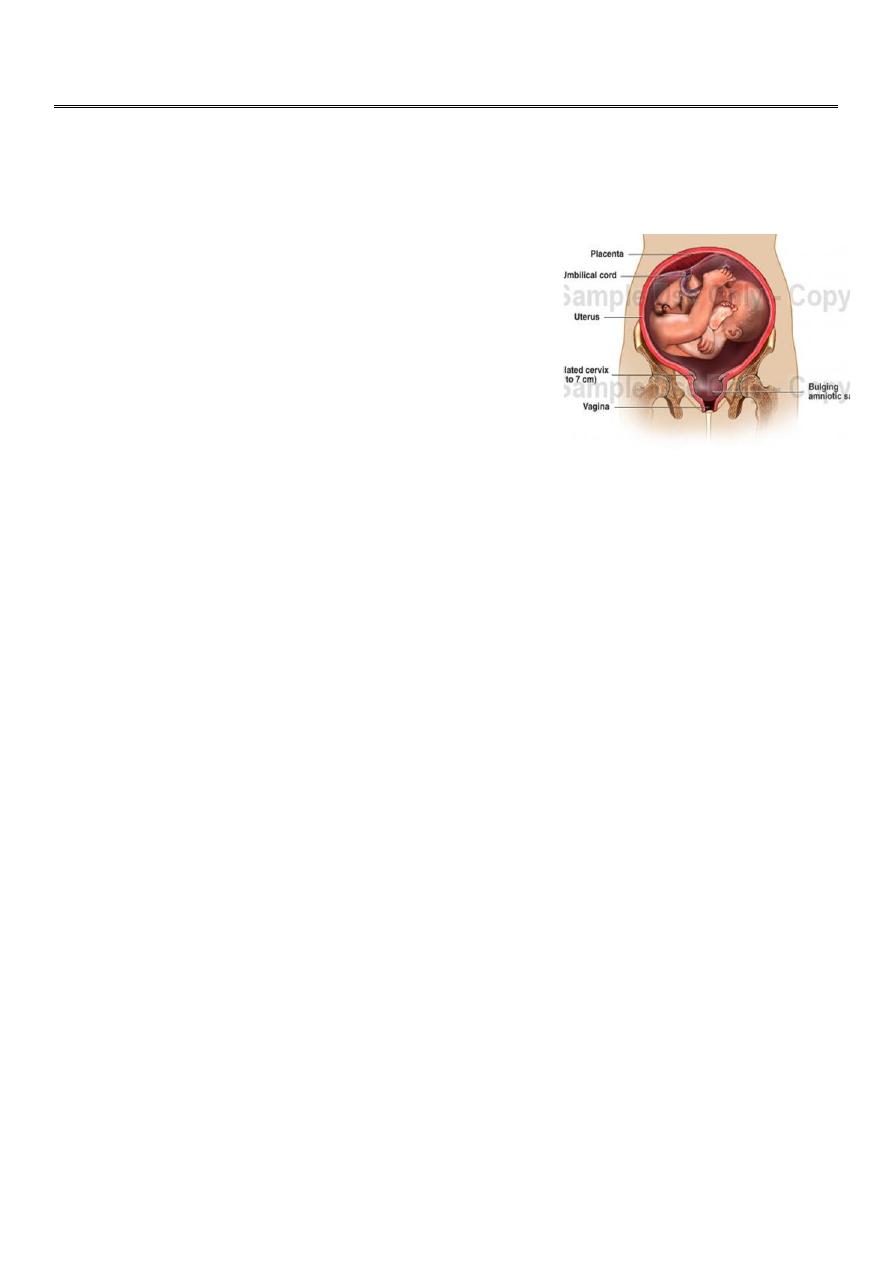
1
Forth stage
Obstetric
Lec-5
.د
ا
سماء
1/1/2016
Transverse lie and oblique lie cord presentation and prolapse
Transverse lie and oblique lie:
The baby lie with it’s long axis transverse or oblique in the
uterus.
Position
:
The fetus may lie in either iliac fossa , with the back
sloping obliquely across the pelvic brim, the breech
occupies higher level in the opposite direction of the abdomen.
Two positions are described:
- Dorsoanterior
-
Dorsoposterior
Aetiology:
- Multiparity.
- Prematurity.
- Polyhydramnios.
- Multiple pregnancy.
- Contracted pelvis,placenta previa ,fibroid.
-
Uterine malformation
Diagnosis
:
Abdominal examination: Uterus appears asymmetrical ,broader and less than expected for
gestational age.
palpation reveals hard head at one iliac fossa and softer breech one the other side. no
presenting part is felt over the brim with the back is felt anteriorely in dorsoanterior and
fetal parts in dorso-posterior.
Vaginal examination:
In early labour the presenting part is high can’t be reached ,membranes may rupture early.
When the cervix become dilated an arm or a loop of cord may prolapse.
Diagnosis of shoulder presentation depends on recognition of acromion process ,scapula
and adjacent ribs.

2
Course of labour:
There is no true mechanism of labour ,Untreated case will ends in obstructed
labour,rupture of uterus and fetal death.
Delivery not occurs until the fetus is macerated or premature. (doubled up)
Treatment :
- Caesarean section should be performed in persistant transverse lie presentation.
- Internal podalic version in delivery of second twin (transverse lie).
- External cephalic version may be tried in selected cases before labour or in early
labour .
- In advanced labour or in case of ruptured membrane C.S. IS SAFER EVEN IN A CASE
OF FETAL DEATH.
Unstable lie :
Is a term used when the fetal lie and presentation is repeatedly changed after 36 weeks of
pregnancy .
The lie being variable between longitudinal, transverse and oblique.
By 36 week the fetus usually adopt stable lie and presentation which will be unchanged
until the onset of labour, Incidence is 0.1% -1% .
Risks of unstable lie :
1) PROM.
2) Cord presentation and cord prolapse.
3) Compound presentation.
4) Uterine rupture.
5) fetal distress and death.
Causes of unstable lie:
1) Multiparty.
2) Polyhydramnios.
3) Multiple pregnancy .
4) Fetal anomaly
5) Placenta previa .
6) Pelvic tumour as fibroid,ovarian cyst.
7) Uterine anomaly.
8) Contracted pelvis or fetal macrosomia.
Management :
Clinical assessment :
History
Examination :
- abdominal examination: to exclude polyhydramnios ,Determine the lie and
presentation.

3
- Pelvic examination : assess the capacity of the Pelvis, tumour in the pelvis (after
excluding placenta previa).
Investigation :
- US : for diagnosis of the lie and presentation and exclusion of the underlying cause.
- X ray : no place if US is available.
Management options for delivery :
No intervention : the lie will become longitudinal in >80% of cases before the onset of
labour. (as out patient or admitted in the hospital till spont.version)
Active: External cephalic version,then induction of labour and low amniotomy
To induce controlled release of liquor use the Drew-smythe catheter with it’s stylet inside
to puncture the amniotic membrane and allows controlled release of liquor.
Elective C.S. at 38- 39 weeks gestation: with version to longitudinal lie during laparotomy if
there is contraindication to external cephalic version or fails or contraindication to vaginal
delivery.
Cord presentation & Cord prolapse :
Cord presentation : is when the cord presented in the birth canal over the cervix with intact
membrane .
Cord prolapse : when the cord prolapsed out of cervix after the sac is ruptured.
Incidence once in 200-300 deliveries.
Aetiology:
- Presenting part does not fill the lower segment.
- Prematurity.
- Multiparty.
- Operative maneuvers. (amniotomy)
- Abnormality of the cord (long, low placental insertion)
- Fetal hypotension (cord is not turgid as in abruptio placentae)
Diagnosis:
Coils of cord may be felt in the fore waters.
If pulsating present distinction is easy .
Cord compression is possible if the liquor is scanty
especially if the head presents.
When the membrane have ruptured the cord
prolapse into the vagina and may protrude out of the
vulva.
Absence of the pulsation in the umbilical cord is
unreliable as evidence of fetal death .

4
Anticipation:
- All patients should come to the hospital early in labour (in 25% of cases occurs before
admission).
- Comes once they notice a leaking liquor even if no contraction.
- Those women at risk (hydramnio ,unstable or oblique lie, malposition , malpresentation
,CPD ) should be admitted electively in late pregnancy.
- Every patient for amniotomy is a potential candidate for C.S., look for the level of the
presenting part before surgical induction, if high then stimulate contraction before
amniotomy and exclude cord prolapse by pelvic examination .
-Fetal heart external monitoring may suggest cord complication even before rupture of the
Membranes.
MANAGEMENT :
Fetus a live and sufficiently mature the ideal is immediate delivery by C.S.While waiting for
C.S. postural treatment involves :
- The cord should be replaced within the warm,moist vagina ,so preventing vasospasm.
- Placing fingers in the vagina lifting the presenting part.
- Placing patient in trendelenberg’s position or Knee elbow position .
- Full the bladder with 500-700 ml of saline ,used when the patient transported for
some distance .
Rare exception:
- When the cervix is fully dilated.
- Multipara.
- Longitudinal lie.
- Normal fetal heart
Choose between C.S. or rapid delivery by vacuum or forceps .
Virtually in all cases of cord prolapse C.S. to be preferred treatment .
In cases of fetal death (absent fetal heart) cord prolapse can be ignored .
Prognosis :
Prompt diagnosis at amniotomy and a short diagnosis to delivery interval result into low
fetal mortality .
Mortality is 5.5% if delivery was effected with in 10 minutes.
C.S. is preferred Because of lower perinatal mortality even in cases approaching full
dilatation cervix.
